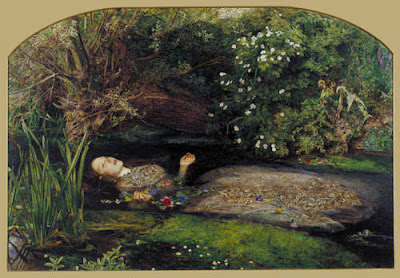 |
| http://en.wikipedia.org/wiki/Victorian_era |
When I was skimming through the various works from the Victorian era, what struck me most was the unique style of the period, which is best characterized as highly ornate, lavish and naturalistic. Victorian style in art was pushed by the Pre-Raphaelite Brotherhood, a group formed in 1848 in London by artists Dante Gabriel Rossetti, John Everett Milliais and William Holman Hunt. The Pre-Raphaelite Brotherhood rejected the pervasive Italian Renaissance art styles and sought a return to genuine art that was painted directly from nature.
 |
| http://painting.about.com/od/figuresportraits/ig/Millais-Paintings/Tate-Millais-Ophelia.htm |
The subject of this painting comes from the poem Mariana by Tennyson (1830), which was inspired by Shakespeare's play Measure for Measure. The woman depicted, Mariana, was rejected by her fiancé after her dowry was lost, and lived a solitary life as consequence. This painting also portrayed the main stream Victorian style in the arts. The use of intensified colors and highly detailed chamber and its accommodations caught my eye immediately. My favorite part is the woman's dress, as I have a penchant for velvet fabrics and Millais perfectly depicts the details of the material. I also noticed the leaves on the desk and floor, which tie in nicely with one of the tenants of the Victorian style: naturalism.
Just about twenty years after Millais painted the epitomes of Victorian art works. Impressionism arose and quickly came about. So please follow up, and I will show you the essence of Impressionism and its influence on modern arts next week.
Just about twenty years after Millais painted the epitomes of Victorian art works. Impressionism arose and quickly came about. So please follow up, and I will show you the essence of Impressionism and its influence on modern arts next week.

No comments:
Post a Comment